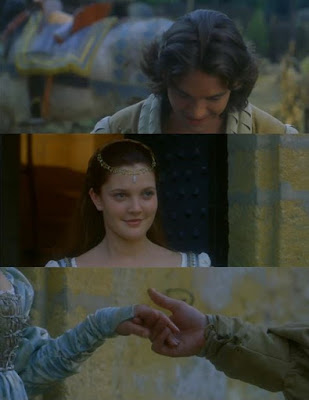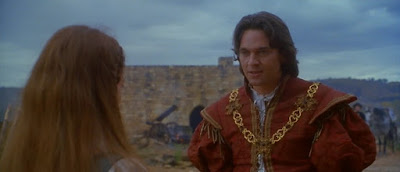And now—with that pre-ramble out of the way—our Ever After post! (Possibly to be known also hereafter as screen cap overdose. ;D)
First off, Ever After has it all: a rich, satisfying wealth of adventure, beauty, humor, character development, masterful storytelling, and poignant, beautiful, twist-your-heartstrings romance. And then there are the gorgeous settings and music! The sixteenth century springs to life with all its breathtaking brilliance, clarity, and exuberance.
I want you to vividly experience the intensity and turns of the story for yourself, so in the following (with great self-restraint) I’m going to try and not give too many spoilers.
However, there are a number of rumblings (vague content rumors and so forth) flying here and there, which is why it initially took me quite a while to see it, not being able to decide what exactly was up with it content-wise. So what I am going to do, is hopefully share the kind of particulars I personally would have found super helpful when trying to make up my mind. (To paraphrase Uncle Max, detailing “every last eensy-teensy frightful little detail.”)
First for some of the misconceptions. The biggest of these I had upon reading the advertising was that Danielle (i.e. Cinderella) was an independent, very modern, sixteenth century feminist. She’s nothing of the kind.
Well educated, strong in her own beliefs, feisty and spirited, yet equally gentle and soft-spoken, showing both honor and respect to the end, she’s absolutely beautiful! (More on her later.)
The second comes from the summary floating around saying something along the lines of “having the courage to make your dreams come true.” From that I got the impression (again) that it would be one of those “follow your heart at the expense of everyone and everything else” type stories. I am going to give a few spoilers on this one below, but let me assure you here and now—it isn’t. Not remotely. (Don’t you love it when the advertisers try to create a blaze? The same thing happened with my copy of N&S.)
Next for the ‘content’ stuff. As aforementioned, it’s robustly in period—permeated to the hilt with rich Renaissance/late-medieval atmosphere. In other words, it’s not Victorian.
Some period idioms are used (i.e. “tub of guts,” for instance) and That Certain Exclamation is used a couple times (for reference, about as much as the ‘95 P&P and in similar context). There are a few innuendos in the market scene wherein Pierre Le Pieu first appears. And there’s one incident with a page near the end (where I think he’s caught attending to some personal business), but it’s NOT overt and really and truly, decidedly un-obvious. Absolutely nothing is shown. Earlier, a lady’s shoulder is shown as she’s slipping on a gown and later her upper back is shown after a whipping. Chamber pots are referenced and emptied out windows.
But please take my word for all this. Really. None of this content is more ‘iffy’ than some stuff in (for another familiar instance) Little Dorrit. In fact, much, much less so. I’m just detailing every last thing I can possibly think of to give as clear and persuasive a picture as possible. :)
Now on to the squeal-worthy part! And here I have to share some trivia facts too delightful to pass up.
#1: The story opens with the brothers Grimm calling on a nineteenth century French queen in her absolutely sumptuous rooms and fact #1 is something I only just noticed when working on this review. Have you ever noticed (those of you who have already seen this) that her bed is Leonardo’s ship from the masquerade ball?
#2: Incredibly (of all his work) it’s one of my two favorite Da Vinci paintings running through the entire story—fitting it with amazing perfection!
#3: I recently found an official movie ranking site had compiled a list of their favorite Cinderella adaptations this spring, reading from bottom to top. I didn’t recognize a lot at first and as I was scrolling I started going, “Oh… Ever After isn’t even getting mentioned in passing.” Based on some of the other variations they had, it seemed like it should at least have made the list. I was getting ruffled, but since (technically) it is a bit of a different take on the story I tried to remain calm and kept scrolling down.
The 2015 Cinderella came up as #2 and I thought, “That’s wild. I wonder what version they can possibly pick for #1?” Trying to will away the butterflies and starting to get excited as whatever-it-was would probably be worth seeing if it topped the 2015 Cinderella, I scrolled one last time and… guess what it was?!?! Yes! Absolutely! Ever After!!!! To say I’m still ecstatic would be an understatement. :)
This is probably the first film I’ve ever seen where I thought every single person (major and minor characters) were utterly and perfectly cast.
There are a number of familiar faces, including Judy Parfitt (whom I’d seen all my growing up in the 80’s P&P as Lady Catherine and then later in Little Dorrit) playing the prince’s mother. And I love her in the part! It’s definitely my favorite of her roles. She’s so warm and gracious and regal!
And… we got all the way through before we realized we’d seen Dougray Scott (Prince Henry) in the Zorro tv show of all exciting wonders! He’s much younger in Zorro, but it’s especially funny as he has a roughly similar character arc—just about seven years earlier.
But now for the rest of the casting:
The young Danielle does excellently and her relationship with her father is absolute perfection.
There are the dear servants.
And Gustave.
Leonardo da Vinci
(“Then you learn to pay attention.”)
The Baroness Rodmilla de Ghent (Danielle’s stepmother).
(“She’s mute, my lord.”)
Marguerite, the nasty stepsister.
And Jacqueline who is SO sweet (with some of the most quote-adaptable comebacks)!
There’s the king (I love how his character changes—I wasn’t expecting it!)
The captain of the guard.
And the de Ghent household’s “benefactor”, Pierre Le Pieu, who is appropriately wicked and creepy.
And of course, the gypsies…
But first and foremost, there’s Danielle de Barbarac and Prince Henry.
During and throughout their various adventures together in river and wood, he treats her with such perfect and thorough respect and honor.
His character arc is incredible.
He becomes a man. And looking back over that arc, the depth and balance of the oft-times conflicting growth within it is astounding.
And there is Danielle herself.
Sometimes it’s easy to lose sight of what true beauty looks like. Courageous strength to risk oneself for a loved one—to say the hard words when called upon—is not incompatible with true femininity. They’re inseparable qualities. Gentleness and grace with fierce loyalty. A clarity of vision and steadfastness of soul. The beauty of a gem wrought—fashioned—bent and shaped to glory through duress and pain, shining even in the darkness with the radiant light lying always at its heart.
Vibrant and pulsating with the potent reality of life, Ever After is a story of grace on the undeserving. The adventure of life is worth every pain—and the weight of glory on the other side is immense.
“While Cinderella and her prince did live happily ever after—the point, gentlemen, is that they lived.”
(And I’m sorry, this one’s blurry, but oh… the joy of it!!!)
In conclusion (and to borrow a phrase from my sister), it’s one of my greatest heart stories—true, good, beautiful, poignant, heady, glory-reflecting story—and I love it hard!



















































0 Comments